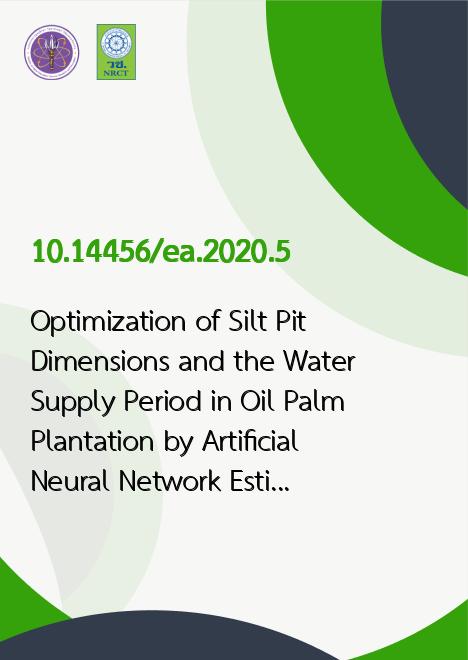
|
Optimization of Silt Pit Dimensions and the Water Supply Period in Oil Palm Plantation by Artificial Neural Network Estimation |
|---|---|
| รหัสดีโอไอ | |
| Creator | 1. Husam Hasan Abdulaali 2. Christopher Teh Boon Sung 3. Ali H. Abdulaali 4. Md Rowshon Kamal 5. Roslan Ismail |
| Title | Optimization of Silt Pit Dimensions and the Water Supply Period in Oil Palm Plantation by Artificial Neural Network Estimation |
| Publisher | Thai Society of Higher Education Institutes on Environment |
| Publication Year | 2563 |
| Journal Title | EnvironmentAsia |
| Journal Vol. | 13 |
| Journal No. | 1 |
| Page no. | 53-66 |
| Keyword | Soil water conservation, Silt pit, HYDRUS-2D/3D, Multiple Linear Regression, Artificial Neural Network |
| URL Website | http://www.tshe.org/ea/index.html |
| Website title | EnvironmentAsia |
| ISSN | 1906-1714 |
| Abstract | Constructing a silt pit is one of the most widely adopted and effective practices used in oil palm plantations to conserve soil and water. The objective of this study was to utilize the HYDRUS-2D/3D to determine the optimal dimensions of silt pit and optimise the simulation results employing the multiple linear regression (MLR) and/or artificial neural network (ANN). Both methods were used to select the optimal size and dimensions of silt pit sizes depending on the amount of rain and soil properties. The treatments that were adopted included: 1) seven soil textures, 2) five surface slopes, and 3) three silt pits sizes. Each silt pit size comprised of three depth levels to accommodate the amount of water available in the pit. The approach first utilised the HYDRUS-2D/3D software to simulate the time-to-empty (TTE) of various silt pit sizes on different soil and slopes. Secondly, trends were then distinguished from the data, and the best fit was determined using MLR and ANN models to estimate the optimal silt pit size. The TTE was affected by the water head in the pits (H), pit width (W), the amount of water applied (Vw), and the pit volume (Vp), but was not affected by the surface slope (Slope). The findings demonstrated that the MLR models did not perform sufficiently to represent the results of TTE (R2 = 0.632; MSE = 85.83) compared with the ANN models (R2 = 0.977; MSE = 10.33). This was mainly due to the non-linear relations of these factors. The results demonstrated that by using the same input data, the ANN models could favourably be used for TTE predictions. |